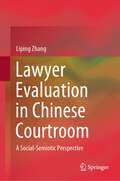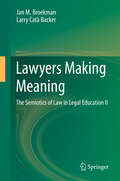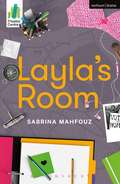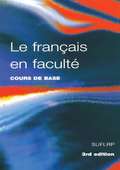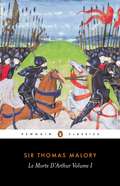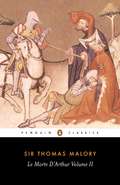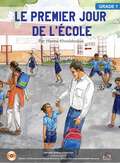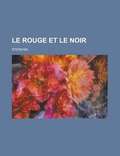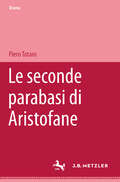- Table View
- List View
The Laws of Cool: Knowledge Work and the Culture of Information
by Alan LiuKnowledge work is now the reigning business paradigm and affects even the world of higher education. But what perspective can the knowledge of the humanities and arts contribute to a world of knowledge work whose primary mission is business? And what is the role of information technology as both the servant of the knowledge economy and the medium of a new technological cool? In The Laws of Cool, Alan Liu reflects on these questions as he considers the emergence of new information technologies and their profound influence on the forms and practices of knowledge.
The Laws of Love: A Brief Historical and Practical Manual (Language, Discourse, Society)
by P. GoodrichYour guest at dinner kisses you. What does it mean? Where does it lead? Does kissing necessarily imply more, and if so how much? These and similar questions of amorous ethics and erotic disquisition are central to our everyday intimate public lives and they are the lost object of the law of love, the lex amatoria collated and presented here.
Lawyer Evaluation in Chinese Courtroom: A Social-Semiotic Perspective
by Liping ZhangThis book focuses on the speech style of lawyer talk in contemporary Chinese courtrooms. The topic is intriguing to readers who may wonder how lawyers compete with their opposing counterparts in an adversarial trial system in China. The legal tradition in Confucianism, which advocates harmony in interpersonal relationships, has historically guided the practice of law in China. The book analyses how lawyers manage to compete in this system. Applying the social semiotic view of language in the Hallidayian sense, specifically systemic functional linguistics and its appraisal theory, this study interprets the subjectivity of legal language by lawyers. The speech style in legal argument presentation is described as 'rational'. The exploration of the rational speech style of lawyers is a theoretical and discursive topic. It draws upon Habermasian philosophy of intersubjectivity in legal argumentation and considers the cultural and legal contexts of China as contextual constraints. The keyconstruct of lawyer evaluation is fully captured in this discussion. As a linguistic phenomenon and unit of analysis, discourse can be examined both within local clauses and in larger stretches of talk beyond clauses. Additionally, it serves as an effective means for constructing a rational speech style for lawyers. Most importantly, discourse is a discursive act that negotiates legal arguments in the dynamic speech exchanges of a court trial, which is embedded in a wider social and cultural context. The book showcases instances of lawyer talk in well-documented trials in China and offers a good opportunity for readers to gain a general understanding of courtroom discourse in the Chinese context. It introduces readers with special interests in legal language and the law to the solidarity dimension of legal language and arguments, an alternative to the confrontational or hostile lawyer talk in trials in countries with a common-law system. The analysis presented is refined and the language used is clear, concise, and objective.
Lawyers at Play: Literature, Law, and Politics at the Early Modern Inns of Court, 1558-1581
by Jessica WinstonMany early modern poets and playwrights were also members of the legal societies the Inns of Court, and these authors shaped the development of key genres of the English Renaissance, especially lyric poetry, dramatic tragedy, satire, and masque. But how did the Inns come to be literary centres in the first place, and why were they especially vibrant at particular times? Early modernists have long understood that urban setting and institutional environment were central to this phenomenon: in the vibrant world of London, educated men with time on their hands turned to literary pastimes for something to do. Lawyers at Play proposes an additional, more essential dynamic: the literary culture of the Inns intensified in decades of profound transformation in the legal profession. Focusing on the first decade of Elizabeth's reign, the period when a large literary network first developed around the societies, this study demonstrates that the literary surge at this time developed out of and responded to a period of rapid expansion in the legal profession and in the career prospects of members. Poetry, translation, and performance were recreational pastimes; however, these activities also defined and elevated the status of inns-of-court men as qualified, learned, and ethical participants in England's 'legal magistracy': those lawyers, judges, justices of the peace, civic office holders, town recorders, and gentleman landholders who managed and administered local and national governance of England. Lawyers at Play maps the literary terrain of a formative but understudied period in the English Renaissance, but it also provides the foundation for an argument that goes beyond the 1560s to provide a framework for understanding the connections between the literary and legal cultures of the Inns over the whole of the early modern period.
Lawyers at Play: Literature, Law, and Politics at the Early Modern Inns of Court, 1558-1581
by Jessica WinstonMany early modern poets and playwrights were also members of the legal societies the Inns of Court, and these authors shaped the development of key genres of the English Renaissance, especially lyric poetry, dramatic tragedy, satire, and masque. But how did the Inns come to be literary centres in the first place, and why were they especially vibrant at particular times? Early modernists have long understood that urban setting and institutional environment were central to this phenomenon: in the vibrant world of London, educated men with time on their hands turned to literary pastimes for something to do. Lawyers at Play proposes an additional, more essential dynamic: the literary culture of the Inns intensified in decades of profound transformation in the legal profession. Focusing on the first decade of Elizabeth's reign, the period when a large literary network first developed around the societies, this study demonstrates that the literary surge at this time developed out of and responded to a period of rapid expansion in the legal profession and in the career prospects of members. Poetry, translation, and performance were recreational pastimes; however, these activities also defined and elevated the status of inns-of-court men as qualified, learned, and ethical participants in England's 'legal magistracy': those lawyers, judges, justices of the peace, civic office holders, town recorders, and gentleman landholders who managed and administered local and national governance of England. Lawyers at Play maps the literary terrain of a formative but understudied period in the English Renaissance, but it also provides the foundation for an argument that goes beyond the 1560s to provide a framework for understanding the connections between the literary and legal cultures of the Inns over the whole of the early modern period.
Lawyers Making Meaning: The Semiotics of Law in Legal Education II
by Jan M. Broekman Larry Catà BackerThis book present a structure for understanding and exploring the semiotic character of law and law systems. Cultivating a deep understanding for the ways in which lawyers make meaning—the way in which they help make the world and are made, in turn by the world they create —can provide a basis for consciously engaging in the work of the law and in the production of meaning. The book first introduces the reader to the idea of semiotics in general and legal semiotics in particular, as well as to the major actors and shapers of the field, and to the heart of the matter: signs. The second part studies the development of the strains of thinking that together now define semiotics, with attention being paid to the pragmatics, psychology and language of legal semiotics. A third part examines the link between legal theory and semiotics, the practice of law, the critical legal studies movement in the USA, the semiotics of politics and structuralism. The last part of the book ties the different strands of legal semiotics together, and closely looks at semiotics in the lawyer’s toolkit—such as: text, name and meaning.
Layers of Learning: Using Read-Alouds to Connect Literacy and Caring Conversations
by JoEllen McCarthyWhat could happen if we viewed every read aloud as an invitation to learn more about literacy and ourselves? In Layers of Learning: Using Read Alouds to Connect Literacy and Caring Conversations , author JoEllen McCarthy explores read aloud strategies designed to enhance your reading and writing standards by capitalizing on the way literature can impact caring communities. Layers of Learning is structured around four key elements: Community, Agency, Respect, and Empowerment, or CARE. The book provides tools necessary to emphasize reading and writing connections, character education, and culturally responsive teaching, all while championing the power of read alouds. Inside you&’ll find: Over 200 picture book suggestions introducing the Heartprint Framework , which demonstrates how you can layer literacy with life lessons 60 read aloud based connections that support caring classroom conversations, lesson planning, and extensions Instructional opportunities for nurturing readers and writers during workshop time, small-group gatherings, or individual conferring sessions Literacy Snapshot photo essays with ideas on how to adopt or adapt Continuing connections with additional resources and invitations for further learning Layers of Learning pulls together the ideas that the books we share not only serve an academic purpose, but also convey big, affective messages. This can lead to richer and more meaningful classroom conversations.
Layers of Learning: Using Read-Alouds to Connect Literacy and Caring Conversations
by JoEllen McCarthyWhat could happen if we viewed every read aloud as an invitation to learn more about literacy and ourselves? In Layers of Learning: Using Read Alouds to Connect Literacy and Caring Conversations , author JoEllen McCarthy explores read aloud strategies designed to enhance your reading and writing standards by capitalizing on the way literature can impact caring communities. Layers of Learning is structured around four key elements: Community, Agency, Respect, and Empowerment, or CARE. The book provides tools necessary to emphasize reading and writing connections, character education, and culturally responsive teaching, all while championing the power of read alouds. Inside you&’ll find: Over 200 picture book suggestions introducing the Heartprint Framework , which demonstrates how you can layer literacy with life lessons 60 read aloud based connections that support caring classroom conversations, lesson planning, and extensions Instructional opportunities for nurturing readers and writers during workshop time, small-group gatherings, or individual conferring sessions Literacy Snapshot photo essays with ideas on how to adopt or adapt Continuing connections with additional resources and invitations for further learning Layers of Learning pulls together the ideas that the books we share not only serve an academic purpose, but also convey big, affective messages. This can lead to richer and more meaningful classroom conversations.
Layla's Room (Modern Plays)
by Sabrina MahfouzRespect women, respect girls. Respect yourselves. Remember you are everyone who's gone before you and you are nobody that has ever been, so make it count, make it special, make a difference, make people listen, love the women who have loved you and watch us make the world move to a better place. For Layla, every day is a battleground.The pay gap, the thigh gap, over-sexed pop and selfies that are photoshopped – they're just part of the world she lives in.But that world is about to change.While breaking out of her bedroom – and with drama, comedy, poetry and music as her weapons – Layla breaks down and makes sense of the realities, difficulties and absurdities of teenage life in the UK today.Collected from a bespoke national survey, the voices of a thousand UK teens are brought to life in Layla. Their ambitions, concerns, role-models and regrets are woven together by award-winning Sabrina Mahfouz and theatre company Theatre Centre, offering a hard-hitting, yet hopeful, story.Layla's Room received its world premiere at Redbridge Drama Centre on 15 September 2016 in a production by Theatre Centre. It is ideal for students and young performers between 16 and 18 years old.
Layla's Room (Modern Plays)
by Sabrina MahfouzRespect women, respect girls. Respect yourselves. Remember you are everyone who's gone before you and you are nobody that has ever been, so make it count, make it special, make a difference, make people listen, love the women who have loved you and watch us make the world move to a better place. For Layla, every day is a battleground.The pay gap, the thigh gap, over-sexed pop and selfies that are photoshopped – they're just part of the world she lives in.But that world is about to change.While breaking out of her bedroom – and with drama, comedy, poetry and music as her weapons – Layla breaks down and makes sense of the realities, difficulties and absurdities of teenage life in the UK today.Collected from a bespoke national survey, the voices of a thousand UK teens are brought to life in Layla. Their ambitions, concerns, role-models and regrets are woven together by award-winning Sabrina Mahfouz and theatre company Theatre Centre, offering a hard-hitting, yet hopeful, story.Layla's Room received its world premiere at Redbridge Drama Centre on 15 September 2016 in a production by Theatre Centre. It is ideal for students and young performers between 16 and 18 years old.
Lazarillo de Tormes (Aris & Phillips Hispanic Classics)
by Keith WhitlockLazarillo de Tormes (1554) is here offered facing the brilliant Tudor English translation of David Rowland of Anglesey (1586). Ostensibly a racy autobiography of a young rogue and his succession of masters, in reality it is a comical and caustic expose of sixteenth century Spanish society, and especially the Church. Rowland's translation exploited the propaganda potential of the text at a time when England and Spain drifted into open war. Lazarillo de Tormes is a key Renaissance humanist text and a formative influence upon European rogue literature and the evolution of realist prose fiction. Keith Whitlock has written a full introduction from a European perspective and provided a comprehensive annotation of the Tudor English. 176p
The Lazarus Case: Life-and-Death Issues in Neonatal Intensive Care (Medicine and Culture)
by John D. LantosIn this new, startlingly original book, John D. Lantos weaves a compelling story that captures the dilemmas of modern medical practice. The Lazarus Case: Life-and-Death Issues in Neonatal Intensive Care begins with a fictional malpractice case—an amalgam of typical cases in which Lantos appeared as an expert witness—and uses it as the framework for addressing the ethical issues surrounding neonatal intensive care. Lantos draws on his experience in neonatal medicine, pediatrics, and medical ethics to explore multiple ethical dilemmas through one poignant representative situation.In Lantos's model case, a doctor decides to stop resuscitation of a premature infant, a tiny "preemie" who seems past reasonable care. The baby survives with severe neurological defects and the parents sue the doctor, alleging that stopping treatment was negligent. From this case, Lantos considers our moral obligations to critically ill babies, the meaning of negligence, and the sorts of social structures that shape the moral consciences of doctors.Each chapter begins with Lantos deposing in the conference room of the plaintiffs' lawyers. The questions put to Lantos throughout the deposition spark an engrossing retelling of his personal experiences with premature babies, as well as his thoughtful discussions of ethics, morality, history, and medical statistics. Sprinkled throughout the book are references to fictional works by Camus, Dostoevsky, Shakespeare, Twain, and others. Lantos uses these literary examples to further illustrate the ambiguities, misunderstandings, responsibilities, and evasions that plague our decisions regarding life and death, medical care and medical education, and ultimately the cost and value of preserving the lives of the most vulnerable among us.
Lazarus, Latenz und die ›Larve der Erinnerung‹: Krieg und Umbruch in der italienischen Literatur des Novecento (Lettre)
by Julia MoldovanIn der italienischen Literatur des 20. Jahrhunderts wird die biblische Figur des Lazarus refunktionalisiert, um sich mit Krieg, Macht und Religion auseinanderzusetzen. Während antifaschistische Autoren anhand der Metapher vor Tyrannei warnen, dient sie profaschistischen Schriftstellern dazu, die Neuentstehung Italiens zu propagieren. Nach dem Zweiten Weltkrieg erscheint Lazarus häufig in Verbindung mit Gewalt, Tod und der Frage nach Schuld. Julia Moldovan leistet einen Beitrag zur Schärfung des Latenzbegriffs und verbindet Theorien aus der Kulturwissenschaft, Philosophie und Psychologie. Mittels einer profunden philologischen Analyse legt sie dar, dass Literatur dazu beitragen kann, traumatische Ereignisse zu reflektieren, die in der Gesellschaft verdrängt werden, aber latent fortbestehen.
Le Fanu's Gothic: The Rhetoric of Darkness
by V. SageThis new study seeks to explore the relations between reader and text across the span of Sheridan Le Fanu's career, placing his early work of the 1830s in context. Sage concentrates on the development in Le Fanu of hybrid forms, which mingle satire and comedy with Gothic horror, and also discusses the early work of Uncle Silas and Carmilla , giving space to the often neglected unpublished romances.
Le Francais en Faculte
by Robin Adamson Geoff Hare James Coleman Margaret Lang Anthony Lodge Richard WakelySubstantially revised and updated, this is the third edition of a highly popular book which has been helping students for decades. It provides a sound base of linguistic competence upon which students can build with confidence. Comprises twelve thematic modules each including a relevant and contemporary text based on an aspect of French life and culture, associated exercises, and a section on grammar.
Le Francais en Faculte
by Robin Adamson Geoff Hare James Coleman Margaret Lang Anthony Lodge Richard WakelySubstantially revised and updated, this is the third edition of a highly popular book which has been helping students for decades. It provides a sound base of linguistic competence upon which students can build with confidence. Comprises twelve thematic modules each including a relevant and contemporary text based on an aspect of French life and culture, associated exercises, and a section on grammar.
Le Gothic: Influences and Appropriations in Europe and America
by Avril HornerThis new collection of essays by major scholars in the field looks at the ways in which cross-fertilization has taken place in Gothic writing from France, Germany, Britain and America over the last 200 years, and argues that Gothic writing reflects international exchanges in theme and form.
Le Morte D'Arthur Volume 1: Studies On The Sources (Le Morte D'Arthur)
by Thomas Malory Janet Cowen John LawlorLe Morte D'Arthur is Sir Thomas Malory's richly evocative and enthralling version of the Arthurian legend. Recounting Arthur's birth, his ascendancy to the throne after claiming Excalibur, his ill-fated marriage to Guenever, the treachery of Morgan le Fay and the exploits of the Knights of the Round Table, it magically weaves together adventure, battle, love and enchantment. Le Morte D'Arthur looks back to an idealized Medieval world and is full of wistful, elegiac regret for a vanished age of chivalry. Edited and published by William Caxton in 1485, Malory's prose romance drew on French and English verse sources to give an epic unity to the Arthur myth, and remains the most magnificent re-telling of the story in English.
Le Morte D'Arthur Volume 2 (Le Morte D'Arthur)
by Thomas Malory Janet Cowen John LawlorVolume two of Le Morte D'Arthur, Sir Thomas Malory's powerful and elegaic version of the Arthurian legend, recounts the adventures of Sir Tristram de Liones and the treachery of Sir Mordred, and follows Sir Launcelot's quest for The Holy Grail, his fatally divided loyalties, and his great, forbidden love for the beautiful Queen Guenever. Culminating in an account of Arthur's final battle against the scheming, deceitful Mordred, this is the definitive re-telling of the Arthurian myth, weaving a story of adultery, treachery and ultimately - in its tragic finale - death. Edited and published by William Caxton in 1485, Malory's moving prose romance looks back to an idealised Medieval age of chivalry, drawing on French and English verse sources to create an epic masterpiece of passion, enchantment, war and betrayal.
Le Premier Jour de l'École class 1 - MIE
by Par Hanna Khodabocus"Le Premier Jour de l'École" plonge les lecteurs dans l'univers excitant et évocateur de la première journée d'école d'un groupe d'enfants en grade 1. L'histoire suit le narrateur, qui découvre sa classe et son enseignante, puis participe à des activités de présentation avec ses camarades. Après cette première partie de la journée, les enfants profitent de la récréation où ils jouent, puis retournent en classe pour dessiner et apprendre. La sonnerie de fin de journée retentit, marquant la fin d'une journée bien remplie. Ce livre, conçu pour les jeunes lecteurs, vise à les immerger dans une expérience familière tout en favorisant leur compréhension du vocabulaire et de la routine de la vie scolaire. L'interaction avec les élèves est encouragée, permettant ainsi d'explorer leurs propres expériences et sentiments concernant leur premier jour à l'école, tout en renforçant leur compréhension du récit.
Le Rouge et le noir
by StendhalPublié quelques mois après les Trois Glorieuses de 1830, Le Rouge et le Noir est l'un des deux ou trois plus grands romans du siècle et l'un des chefs-d'œuvre de la littérature universelle. Inspiré d'un fait divers célèbre de l'époque - Antoine Berthet avait été condamné à mort en 1828 par les assises de l'Isère pour tentative de meurtre sur la personne de Mme Michoud chez qui il était précepteur -, Le Rouge et le Noir est l'histoire d'un jeune homme ambitieux qui se sert des femmes pour réussir et qui rachète ses erreurs par une inflexible énergie. Manuel de l'ambition et de la rébellion, Le Rouge et le Noir est aussi et d'abord un roman d'amour. Julien Sorel annonce peut-être, en un sens, la lutte des classes. Marchant dans les pas de Valmont et de Don Juan, il annonce aussi tous les thèmes de la liberté sexuelle d'aujourd'hui. Julien Sorel passe et les femmes tombent dans ses bras. Ce qui frappe, chez Stendhal, c'est le contraste entre l'échec en son temps et son prodigieux succès dans le nôtre. Il a échoué dans la vie et dans sa chasse au bonheur ; il a réussi au-delà de toute espérance dans sa quête de futur." Je mets, disait-il, un billet à la loterie dont le gros lot se réduit à ceci : être lu en 1935 ". Soixante-quinze ans après la date fixée, Stendhal, méprisé et moqué par ses contemporains, est adulé par les nôtres. Valéry et Gide saluent en lui le romancier le plus intelligent de notre littérature et un classique de la modernité.
Le seconde parabasi di Aristofane
by Piero TotaroDie Nebenparabasen in den Komödien des Aristophanes.
Le Week-end
by Hanif KureishiIn Le Weekend, a couple - married for 30 years - spend their wedding anniversary in Paris. However, the romantic city soon becomes a backdrop to their increasingly bitter disputes about the state of their marriage - and their lives.But, as they gradually become part of the rhythm of the city - its cafes and monuments - the tension that has burdened them fades as they re-discover the playfulness and anarchy of their youth.Their melancholy dissolves in a sense of delight in irresponsibility, and gives them a new lease of life
The Lea Guide To Composition
by James D. WilliamsThe LEA Guide to Composition is firmly based on research into how people learn to write and draws on the most significant strategies and techniques in composition studies. But this text is not just about the act of writing. It is about using writing as a vehicle for learning--about the world, about the academy, about oneself. The focus is on writing as a means of interpretation. The emphasis throughout is on encouraging reflection and developing critical thinking skills. Although the text suggests ways of teaching that reflect knowledge about how people most easily learn to become competent writers, it is specifically designed to allow for numerous approaches to teaching composition. Instructors will value this flexibility. This text is finely tuned to the needs and interests of today's composition students and teachers. Classroom tested at various universities over a four-year period to refine and improve its effectiveness, the Guide is distinguished by a range of carefully crafted instructional features: *Reading-Writing Connection. An extensive selection of fresh, thought-provoking, professional work allows students to internalize models and acquire appropriate genre familiarity. Student papers are included to illustrate how others have responded to real writing tasks similar to those the readers of this book will face. *Critical Reading and Thinking. Numerous reading selections are thoroughly analyzed to provide models of close, critical reading. Critical Reading Guides, provided for some selections, draw students in by asking rhetorical questions that develop critical thinking skills and better understanding of how the authors produced key effects. *Diverse Voices. Specially designed writing activities encourage students who are non-native speakers of English, or who come from non-mainstream cultural backgrounds, to share their perspectives with the entire class. *Writing Activities. More than 60 writing activities of various types are included, suitable for students with a range of writing experience. Many of these are short assignments that are linked to longer ones, which allows students to build their skills sequentially, adding new skills as old ones are practiced and mastered. *Writing Guides. Based on years of teaching experience, these guides provide detailed information and concrete, practical advice about how to succeed on selected assignments in each chapter. *Group Activities. Selected writing assignments include collaborative workshop activities that prompt students to engage in a variety of group efforts that enhance the writing process. As a result, group work progresses with a clear purpose and well-defined goals, leading to more student involvement and, ultimately, better writing. *Application of Key Ideas. Writing Assignments, Writing Guides, and Critical Reading Guides are complemented by activities that allow students to practice using important concepts discussed in the text that progress with a clear purpose and well-defined before they begin an actual assignment. *Journal Entries. Prompts throughout the text are included to increase the amount of writing students do, to enhance reflection and critical thinking, and to engage students in reflecting on and making connections between college and their lives outside of class. *Handbook. The handbook provides basic information about the form and function of language. It focuses on the usage conventions that are a crucial part of academic writing. In addition, it covers differences and similarities in the specific conventions that govern writing in the humanities, social sciences, and science. The documentation formats for these three major divisions of the undergraduate curriculum are described in detail, with full-length student papers to illustrate the formats in context. An Instructor's Manual is available with this text, upon adoption.
The Lea Guide To Composition
by James D. WilliamsThe LEA Guide to Composition is firmly based on research into how people learn to write and draws on the most significant strategies and techniques in composition studies. But this text is not just about the act of writing. It is about using writing as a vehicle for learning--about the world, about the academy, about oneself. The focus is on writing as a means of interpretation. The emphasis throughout is on encouraging reflection and developing critical thinking skills. Although the text suggests ways of teaching that reflect knowledge about how people most easily learn to become competent writers, it is specifically designed to allow for numerous approaches to teaching composition. Instructors will value this flexibility. This text is finely tuned to the needs and interests of today's composition students and teachers. Classroom tested at various universities over a four-year period to refine and improve its effectiveness, the Guide is distinguished by a range of carefully crafted instructional features: *Reading-Writing Connection. An extensive selection of fresh, thought-provoking, professional work allows students to internalize models and acquire appropriate genre familiarity. Student papers are included to illustrate how others have responded to real writing tasks similar to those the readers of this book will face. *Critical Reading and Thinking. Numerous reading selections are thoroughly analyzed to provide models of close, critical reading. Critical Reading Guides, provided for some selections, draw students in by asking rhetorical questions that develop critical thinking skills and better understanding of how the authors produced key effects. *Diverse Voices. Specially designed writing activities encourage students who are non-native speakers of English, or who come from non-mainstream cultural backgrounds, to share their perspectives with the entire class. *Writing Activities. More than 60 writing activities of various types are included, suitable for students with a range of writing experience. Many of these are short assignments that are linked to longer ones, which allows students to build their skills sequentially, adding new skills as old ones are practiced and mastered. *Writing Guides. Based on years of teaching experience, these guides provide detailed information and concrete, practical advice about how to succeed on selected assignments in each chapter. *Group Activities. Selected writing assignments include collaborative workshop activities that prompt students to engage in a variety of group efforts that enhance the writing process. As a result, group work progresses with a clear purpose and well-defined goals, leading to more student involvement and, ultimately, better writing. *Application of Key Ideas. Writing Assignments, Writing Guides, and Critical Reading Guides are complemented by activities that allow students to practice using important concepts discussed in the text that progress with a clear purpose and well-defined before they begin an actual assignment. *Journal Entries. Prompts throughout the text are included to increase the amount of writing students do, to enhance reflection and critical thinking, and to engage students in reflecting on and making connections between college and their lives outside of class. *Handbook. The handbook provides basic information about the form and function of language. It focuses on the usage conventions that are a crucial part of academic writing. In addition, it covers differences and similarities in the specific conventions that govern writing in the humanities, social sciences, and science. The documentation formats for these three major divisions of the undergraduate curriculum are described in detail, with full-length student papers to illustrate the formats in context. An Instructor's Manual is available with this text, upon adoption.


